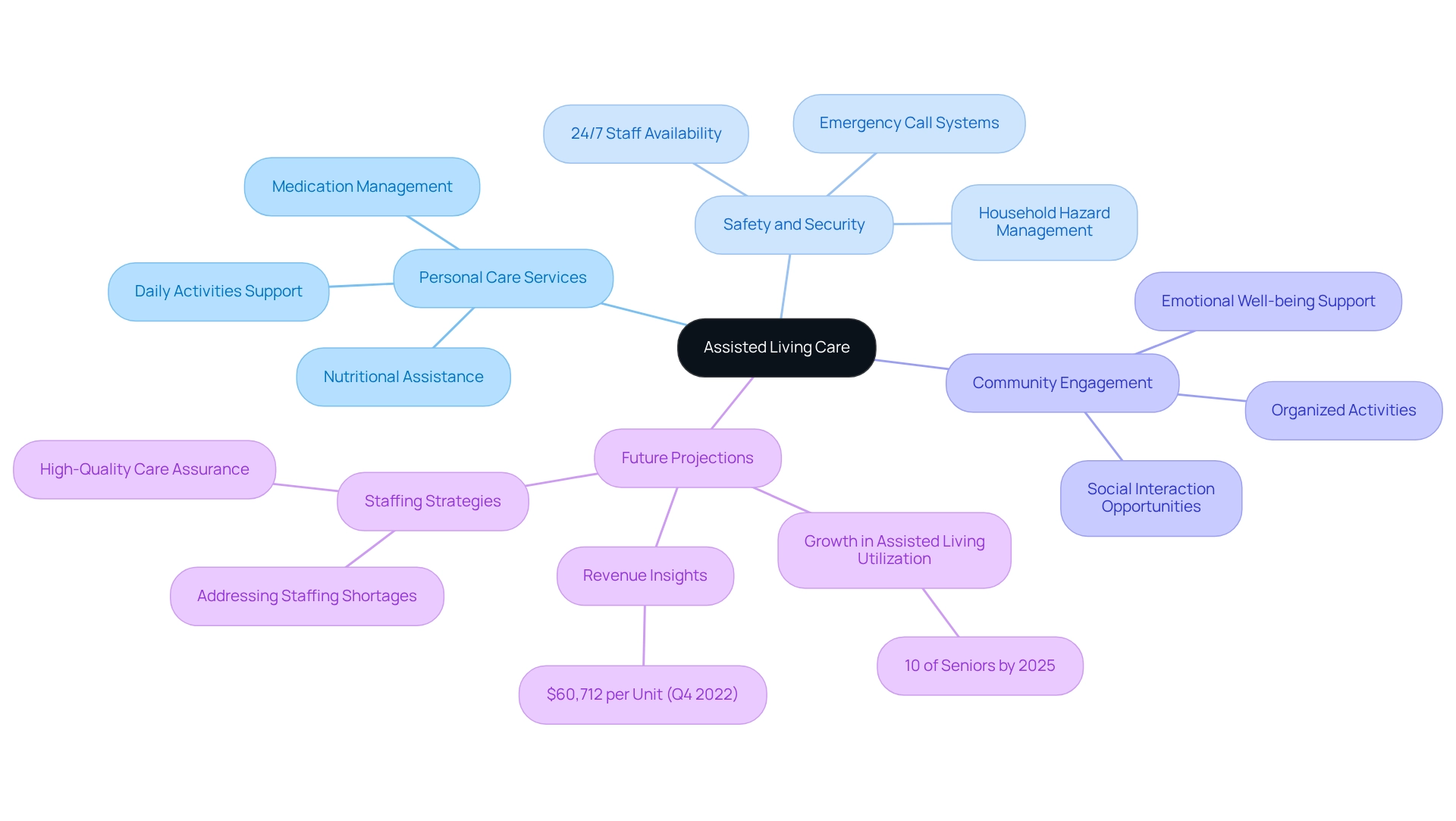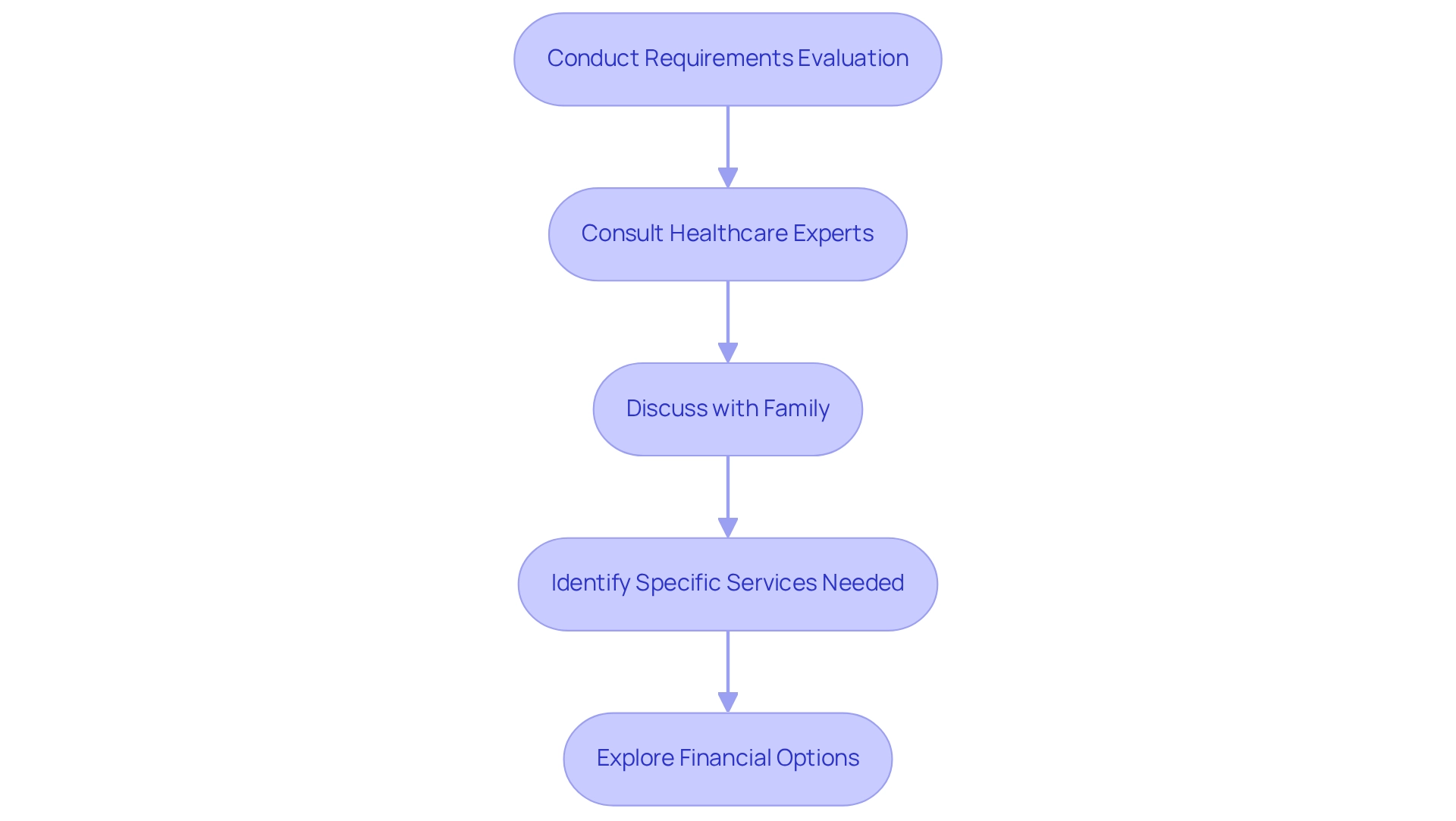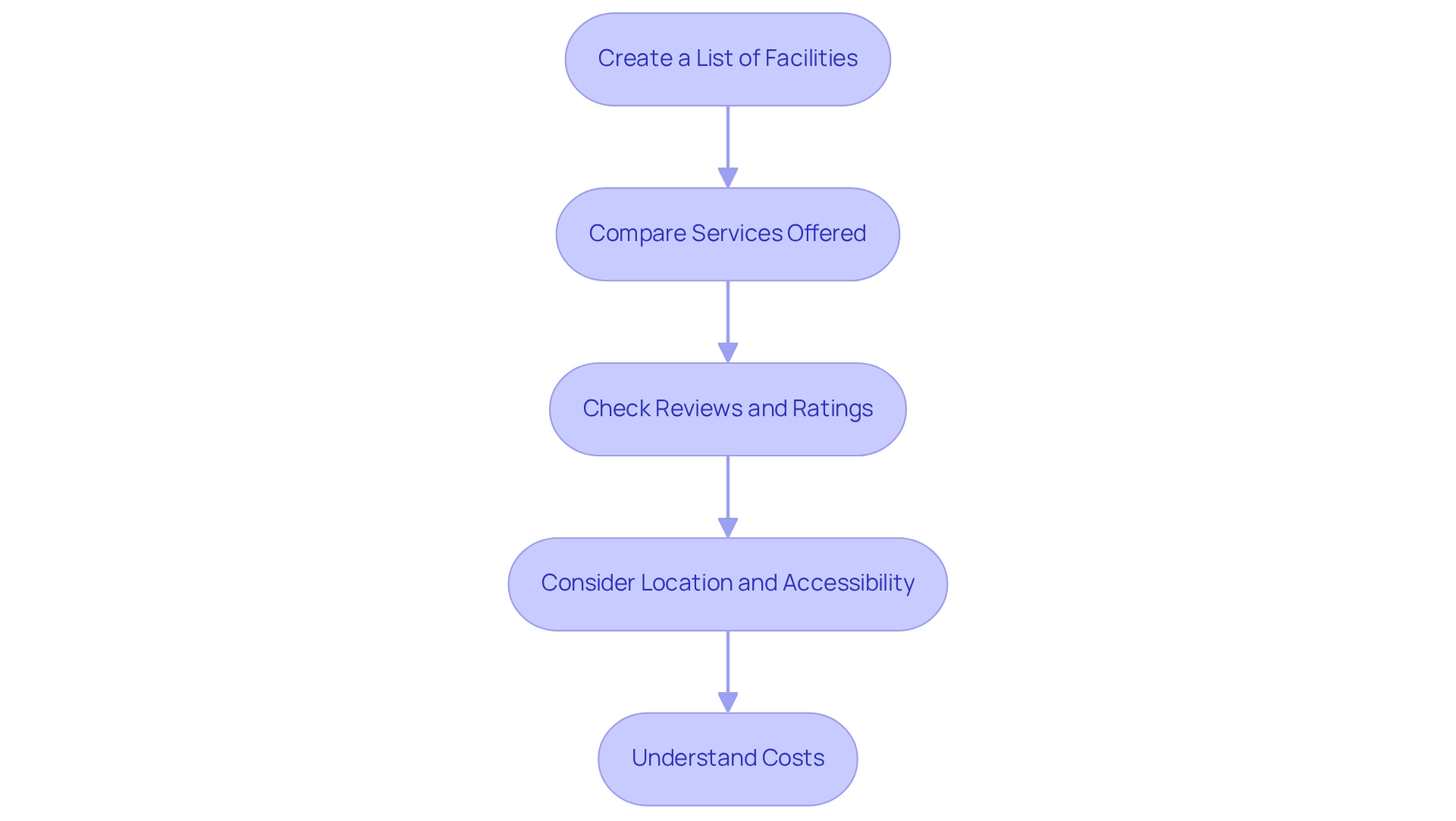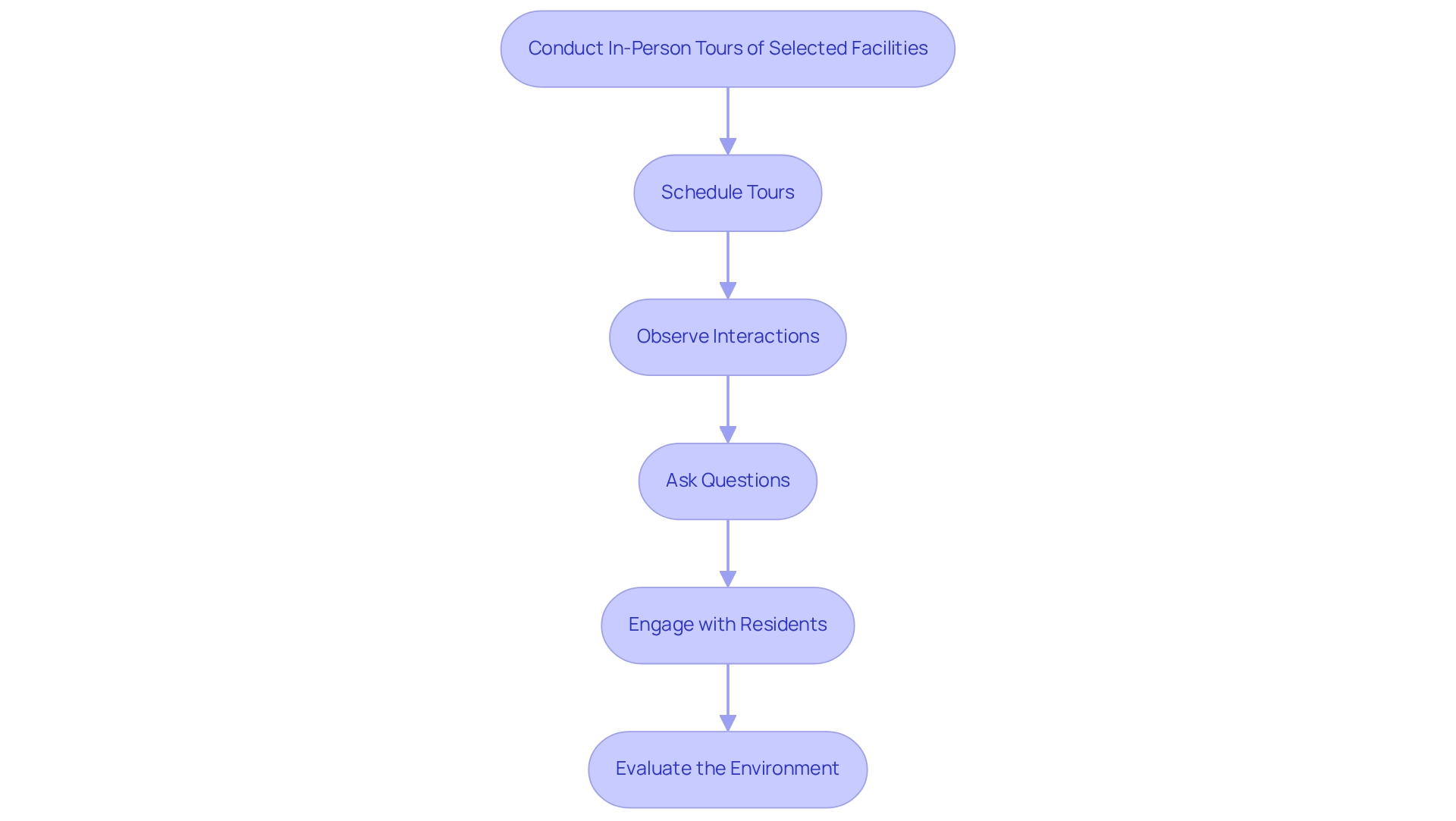Overview
Navigating assisted living care for your loved ones can feel overwhelming, but understanding the essential steps can provide clarity and peace of mind. First, it’s important to grasp the concepts of assisted living, as this knowledge lays the foundation for informed decisions. Next, evaluating individual care needs ensures that the specific requirements of your loved one are recognized and addressed.
In addition, researching facilities is crucial; it allows you to explore various options that align with those needs. Furthermore, conducting in-person visits can offer invaluable insights into the environment and care provided, helping you gauge whether it feels like the right fit. Each of these steps underscores the importance of personalized assessment, thorough research, and direct engagement with potential care environments.
Ultimately, ensuring that seniors receive appropriate support tailored to their specific needs enhances their overall quality of life. Remember, you are not alone in this journey; we’re here for you every step of the way. Your loved one’s comfort and well-being are our top priorities, and taking these steps can lead to a nurturing and supportive living situation.
Introduction
Navigating the world of assisted living can feel overwhelming for families who are seeking the best care for their loved ones. As our aging population continues to grow, it becomes increasingly important to understand the nuances of assisted living, ensuring that you can make informed decisions. This article explores essential aspects of assisted living, from the key services offered to evaluating individual care needs and the process of researching and visiting facilities. By delving into these critical elements, we hope to empower families to ensure their loved ones receive the support and community they deserve, fostering a fulfilling and safe living environment during their later years. Remember, you’re not alone in this journey; we’re here for you every step of the way.
Understand Assisted Living: Key Concepts and Definitions
Assisted living care serves as a vital residential option for seniors who need support with daily tasks but do not require the extensive medical care found in nursing facilities. This compassionate approach ensures that residents can thrive while receiving the assistance they need. The key features of assisted living include:
- Personal Care Services: These services provide essential support with daily activities such as bathing, dressing, and medication management. This personalized care is crucial, as it helps prevent health declines, poor nutrition, and hygiene issues that can arise without proper assistance.
- Safety and Security: Designed with resident safety in mind, these facilities typically feature emergency call systems and staff available around the clock. This provides peace of mind to both residents and their families. Caregivers also help manage household hazards, ensuring a safe home environment.
Assisted living care facilities foster a sense of community by offering numerous opportunities for social interaction and participation through organized activities. These connections are essential for emotional well-being and combating loneliness, alleviating feelings of isolation and depression, and enhancing overall quality of life.
A fundamental aspect of assisted living care is the ability for residents to maintain independence while receiving necessary assistance. This balance is essential for preserving dignity and enhancing quality of life. Caregiver services can be tailored to fit seniors’ specific needs, offering flexibility and convenience.
As we look ahead to 2025, around 10% of seniors are expected to utilize assisted living care services, reflecting a growing preference for environments that provide assistance. The income per supportive housing unit is reported to be $60,712 as of Q4 2022, indicating the economic viability of these establishments. With the anticipated growth in the older population, the supportive housing sector is predicted to expand significantly, necessitating innovative service provision models that emphasize individual support and social interaction.
According to the case study titled ‘Future Projections for Assisted Living,’ proactive strategies will be crucial for addressing staffing shortages and ensuring high-quality assisted living care as the number of older adults requiring assisted living care continues to rise. Effective support models highlight the importance of nurturing vibrant social settings that meet the comprehensive needs of older adults, ensuring they flourish in their later years. As Amanda McGrory-Dixon, Content Marketing Manager at Aline, states, “Aline provides a thorough solution to navigate the changing environment of senior care, assisting operators in enhancing performance, boosting revenue growth, and maintaining an advantage in a competitive market.” Staying informed about industry trends is essential for operators to prepare for the future needs of supportive care.

Evaluate Care Needs: Assessing Individual Requirements for Assisted Living
To effectively assess care requirements for assisted living, it’s important to follow these essential steps:
-
Conduct a Requirements Evaluation: Begin by examining your loved one’s physical, emotional, and social needs. This assessment should include their ability to perform daily activities independently, which is crucial for determining the level of assistance required. Look for signs such as difficulty with personal hygiene, dressing, cooking, cleaning, or managing medications, as these may indicate the need for CNA/HHA caregiver services.
-
Consult Healthcare Experts: Engage with physicians or geriatric managers who can provide valuable insights into the necessary level of support. Their expertise is vital in understanding specific health conditions and the support required. Health concerns like managing chronic conditions or frequent hospitalizations are important factors to consider.
-
Discuss with Family: Involve family members in discussions to gather diverse perspectives on the individual’s needs and preferences. This collaborative approach ensures that all viewpoints are considered, leading to a more comprehensive understanding of support needs. Discussing the potential benefits of companion or sitter services can also enhance your loved one’s quality of life and independence.
-
Identify Specific Services Needed: Determine if your loved one requires assistance with medication management, mobility, or specialized support for chronic conditions. Understanding these specific requirements will aid in choosing the most suitable assisted care services. Notably, 24-hour elder assistance not only provides essential support but may also be covered by Medicare, making it a viable option for many families. Additionally, consider the flexibility of companion or sitter services, which can be tailored to fit particular needs and schedules.
It’s crucial to highlight that CNAs (Certified Nursing Assistants) undergo comprehensive training focused on medical duties, while HHAs (Home Health Aides) are primarily trained for personal support and daily living tasks. Maintaining transparent communication with caregivers and the home support agency is vital for ensuring quality assistance. Statistics indicate that residents between the ages of 31 and 64 account for approximately 7% of long-term support residents, underscoring the importance of personalized evaluations for individuals of all ages. Furthermore, considering the financial aspects of extended support is essential; as Claire Samuels pointed out, out-of-pocket expenses constitute 13.5% of total long-term support expenditures. By following these steps and consulting healthcare professionals, families can make informed decisions that enhance the quality of life for their loved ones. Moreover, exploring alternatives such as service-enhanced housing, which combines affordable rental accommodations with supportive services, can provide additional assistance in addressing support needs.

Research Facilities: Compare Options and Services Offered
When researching assisted living care facilities, it’s essential to follow a systematic approach to ensure you find the best fit for your loved one. Start by creating a list of potential facilities. Gather information from online resources, referrals from healthcare providers, and recommendations from friends or family. This will help you compile a diverse list of options that cater to your loved one’s needs.
Next, compare the services offered by each facility. Evaluate them based on the specific services they provide, seeking vital offerings like memory support, physical therapy, and social activities. These can greatly influence your loved one’s quality of life and overall happiness.
It’s also important to check reviews and ratings. Utilize platforms like U.S. News and other senior care rating sites to assess the reputation of each facility. Reviews can provide valuable insights into the experiences of other residents and their families, highlighting strengths and potential concerns that may affect your decision.
Additionally, consider location and accessibility. Ensure that the facility is conveniently located for family visits and has easy access to local amenities. Proximity can enhance the overall experience for both residents and their families, making it easier to maintain those cherished connections.
As of 2023, the typical expense of support residences in Miami and Fort Lauderdale varies from $3,000 to $5,000 each month, based on the degree of support and services offered. Meal plans in supportive care communities typically range from $3 to $10 daily, contributing to the total monthly costs. Furthermore, the median duration of residence in support facilities is around 22 months, offering context for families evaluating long-term options. With the anticipated demand for almost 775,000 additional supportive housing units by 2030, grasping these factors is essential for making knowledgeable choices.
As John Hauber, CEO of HavenCo, states, “To navigate the investment chasm in the senior housing landscape, a multi-pronged approach that blends financial savvy with innovative development is indispensable.” By adhering to these steps, families can manage the intricacies of support services and locate a facility that offers assisted living care to meet their loved one’s specific requirements. Remember, you’re not alone in this journey; we’re here for you, and your comfort is our priority.

Visit and Evaluate: Conduct In-Person Tours of Selected Facilities
To maximize the effectiveness of your visits to assisted living facilities, consider these strategies designed with your concerns in mind:
- Schedule Tours: Arrange visits to multiple facilities to evaluate their environments, services, and overall support strategies. This step is crucial in finding the right fit for your loved one.
- Observe Interactions: Pay close attention to staff interactions with residents. Friendly and attentive behavior is essential for fostering a supportive atmosphere. As a senior health professional noted, “The manner in which staff interact with residents can greatly influence their overall well-being and satisfaction.”
- Ask Questions: Inquire about essential aspects such as staff training, resident-to-staff ratios, and protocols for handling emergencies. Understanding these factors can provide insight into the standard of service. It’s important to recognize that CNAs (Certified Nursing Assistants) undergo comprehensive training focused on medical duties, while HHAs (Home Health Aides) are primarily prepared for personal care and daily activities.
- Engage with Residents: Whenever possible, converse with current residents and their families. Their firsthand experiences can offer valuable perspectives on daily life within the facility, helping you feel more connected to the environment.
- Evaluate the Environment: Assess the cleanliness, safety features, and overall ambiance of the facility. A welcoming and well-maintained environment is vital for residents’ comfort and well-being.
These steps are especially crucial considering that 64% of care home residents require help with bathing, 57% require aid walking, and 48% require support with dressing. Watching how staff handle these requirements can significantly impact your decision-making process. Furthermore, statistics show that family involvement is essential; regular visits can enhance residents’ emotional well-being. The median duration of residence in assisted living care communities is 22 months, emphasizing the importance of choosing a facility that can adapt to evolving support needs over time. Additionally, families should be aware of key indicators suggesting the need for additional caregiver services, such as difficulties with personal hygiene, cooking, or managing medications, as well as any ongoing health concerns. Keeping transparent dialogue with caregivers and the home support agency is crucial to ensuring quality assistance. This comprehensive evaluation will help ensure that your loved one receives the quality care they deserve, reminding you that we’re here for you every step of the way.

Conclusion
Navigating the complexities of assisted living is an essential journey for families who want the best care for their loved ones. By understanding key features of assisted living—such as personal care services, social environments, safety measures, and the importance of maintaining independence—families can make informed decisions that truly reflect their needs. Recognizing the growing trend of seniors utilizing these services underscores the necessity of adapting to the evolving needs of our aging population.
Evaluating individual care needs through structured assessments, consultations with healthcare professionals, and heartfelt family discussions is vital. This tailored approach ensures that the right support is provided for each person, enhancing their quality of life and well-being. Identifying specific services required allows families to choose a facility that meets the unique needs of residents, fostering a nurturing environment.
Researching potential facilities should involve a systematic approach, including:
- Comparing services
- Checking reviews
- Considering location
In-person visits are invaluable; they allow families to assess the environment and observe the quality of interactions between staff and residents. These insights provide a deeper understanding of the overall atmosphere of a facility, which is crucial in making the right choice.
Ultimately, finding the right assisted living facility goes beyond just meeting basic needs; it’s about creating a supportive community that enriches the lives of seniors. By following these guidelines, families can ensure that their loved ones receive the compassionate care and fulfilling environment they deserve, empowering them to thrive in their later years. Remember, we’re here for you every step of the way, and your loved one’s comfort is our priority.
Frequently Asked Questions
What is assisted living care?
Assisted living care is a residential option for seniors who need support with daily tasks but do not require extensive medical care found in nursing facilities. It aims to help residents thrive while receiving necessary assistance.
What personal care services are offered in assisted living?
Assisted living facilities provide essential support with daily activities such as bathing, dressing, and medication management. This personalized care is crucial for preventing health declines, poor nutrition, and hygiene issues.
How does assisted living ensure safety and security for residents?
Assisted living facilities are designed with resident safety in mind, featuring emergency call systems and staff available around the clock. Caregivers also help manage household hazards to ensure a safe home environment.
What role does social interaction play in assisted living?
Assisted living care fosters a sense of community by offering numerous opportunities for social interaction through organized activities. These connections are vital for emotional well-being, combating loneliness, and enhancing overall quality of life.
How does assisted living support residents’ independence?
A fundamental aspect of assisted living care is allowing residents to maintain independence while receiving necessary assistance. Caregiver services can be tailored to fit seniors’ specific needs, providing flexibility and convenience.
What is the projected growth in the use of assisted living care services by 2025?
By 2025, around 10% of seniors are expected to utilize assisted living care services, indicating a growing preference for environments that provide assistance.
What is the reported income per supportive housing unit as of Q4 2022?
The income per supportive housing unit is reported to be $60,712 as of Q4 2022, reflecting the economic viability of assisted living establishments.
What challenges does the assisted living sector face in the future?
The assisted living sector will face challenges such as staffing shortages and the need for high-quality care as the number of older adults requiring assisted living continues to rise. Proactive strategies will be crucial to address these issues.
Why is it important for operators to stay informed about industry trends?
Staying informed about industry trends is essential for operators to prepare for the future needs of supportive care, enhance performance, boost revenue growth, and maintain a competitive advantage in the market.










